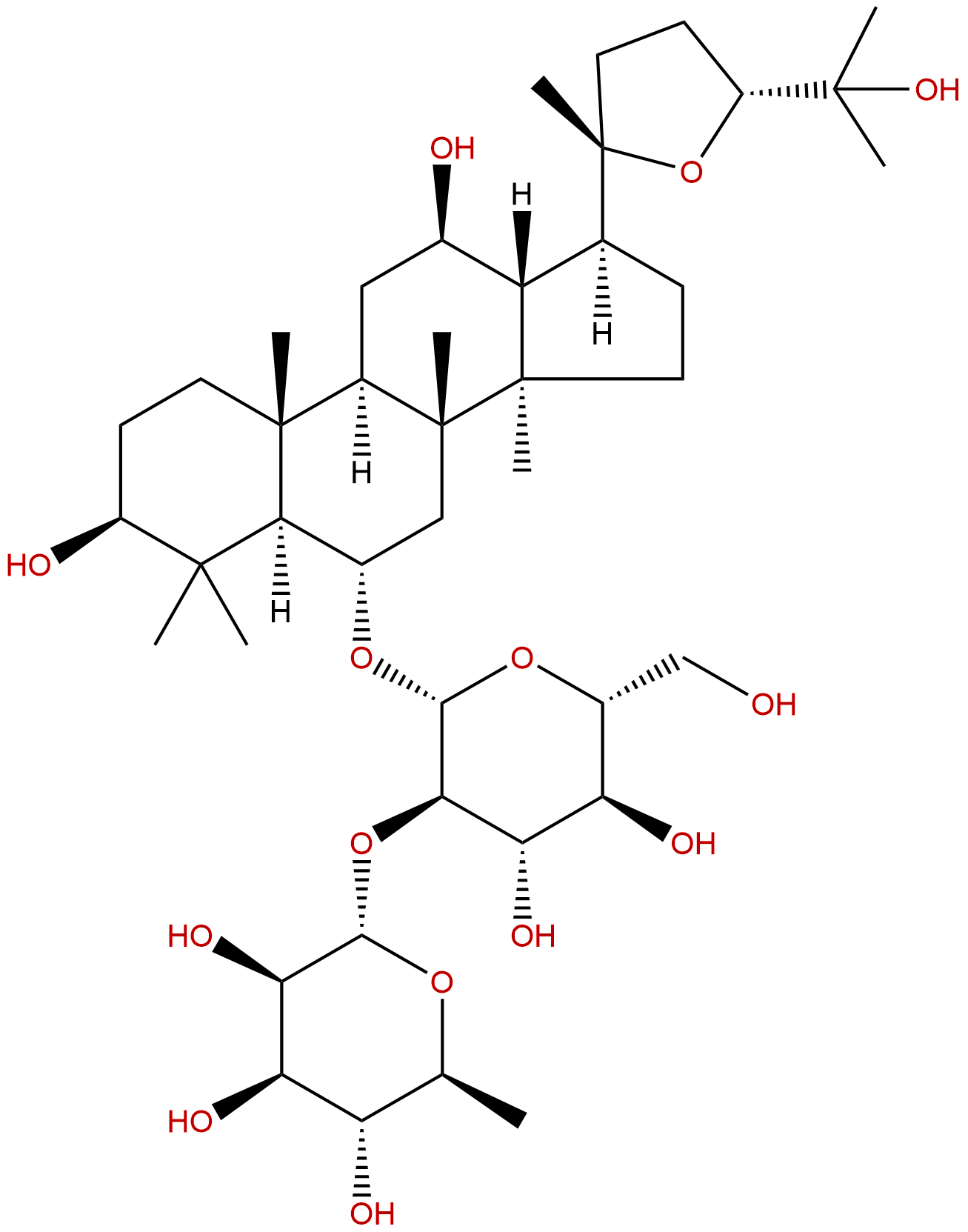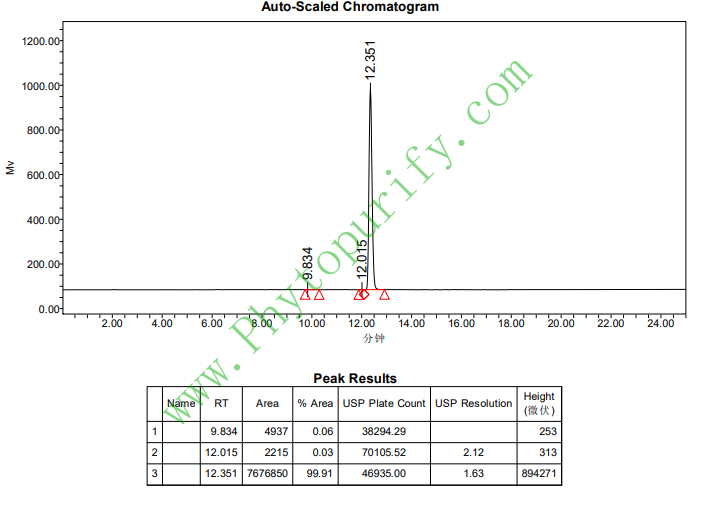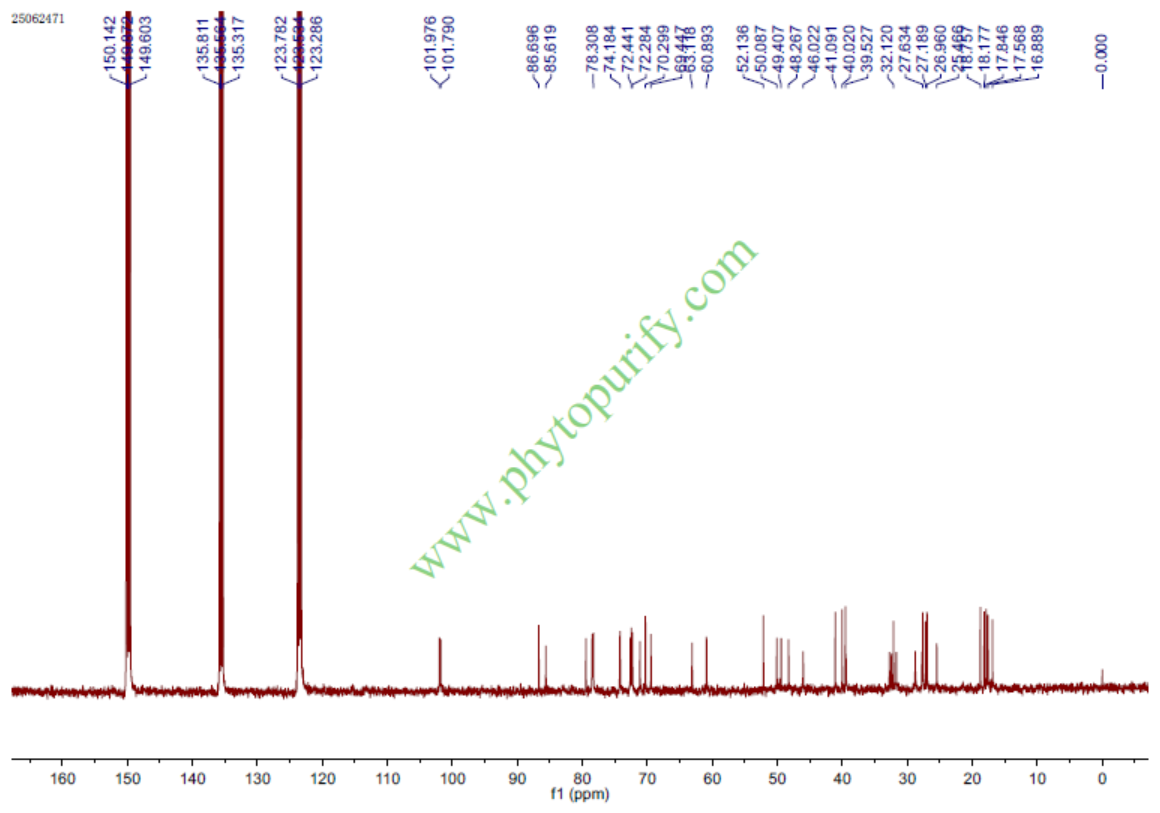
Pseudoginsenoside F11CAS No.:69884-00-0
|
||||||||||
 |
|
|
||||||||

| Catalogue No.: | BP1164 |
| Formula: | C42H72O14 |
| Mol Weight: | 801.024 |
Synonym name: Ginsenoside A1
Catalogue No.: BP1164
Cas No.: 69884-00-0
Formula: C42H72O14
Mol Weight: 801.013
Botanical Source: Panax ginseng
Purity: 95%~99%
Analysis Method: HPLC-DAD or/and HPLC-ELSD
Identification Method: Mass, NMR
Packing: Brown vial or HDPE plastic bottle
Can be supplied from milligrams to grams. Inquire for bulk scale.
For Reference Standard and R&D, Not for Human Use Directly.
Description:
Pseudoginsenoside F11, a novel partial PPAR γ agonist, can promote adiponectin oligomerization and secretion in 3T3-L1 adipocytes and inhibit obesity-linked phosphorylation of PPAR γ at Ser-273 by Cdk5. It possesses significant neuroprotective activity, has been demonstrated to antagonize the learning and memory deficits induced by scopolamine, morphine and methamphetamine in mice; it also antagonizes the development of analgesia tolerance to morphine and blocks the development of morphine-induced behavioral sensitization via its effect, at least partially, on the glutamatergic system in the mPFC.
References:
Neuropharmacology. 2014 Apr;79:642-56.
Pseudoginsenoside-F11 (PF11) exerts anti-neuroinflammatory effects on LPS-activated microglial cells by inhibiting TLR4-mediated TAK1/IKK/NF-κB, MAPKs and Akt signaling pathways.
Pseudoginsenoside-F11 (PF11), an ocotillol-type ginsenoside, has been shown to possess significant neuroprotective activity. Since microglia-mediated inflammation is critical for induction of neurodegeneration, this study was designed to investigate the effect of PF11 on activated microglia.
METHODS AND RESULTS:
PF11 significantly suppressed the release of ROS and proinflammatory mediators induced by LPS in a microglial cell line N9 including NO, PGE2, IL-1β, IL-6 and TNF-α. Moreover, PF11 inhibited interaction and expression of TLR4 and MyD88 in LPS-activated N9 cells, resulting in an inhibition of the TAK1/IKK/NF-κB signaling pathway. PF11 also inhibited the phosphorylation of Akt and MAPKs induced by LPS in N9 cells. Importantly, PF11 significantly alleviated the death of SH-SY5Y neuroblastoma cells and primary cortical neurons induced by the conditioned-medium from activated microglia. At last, the effect of PF11 on neuroinflammation was confirmed in vivo: PF11 mitigated the microglial activation and proinflammatory factors expression obviously in both cortex and hippocampus in mice injected intrahippocampally with LPS.
CONCLUSIONS:
These findings indicate that PF11 exerts anti-neuroinflammatory effects on LPS-activated microglial cells by inhibiting TLR4-mediated TAK1/IKK/NF-κB, MAPKs and Akt signaling pathways, suggesting its therapeutic implication for neurodegenerative disease associated with neuroinflammation.
Sci Rep. 2014 May 16;4:4986.
The pseudoginsenoside F11 ameliorates cisplatin-induced nephrotoxicity without compromising its anti-tumor activity in vivo.
The clinical use of cisplatin was severely limited by its associated nephrotoxicity. In this study, we investigated whether the Pseudoginsenoside F11 had protective effects against cisplatin-induced nephrotoxicity.
METHODS AND RESULTS:
To clarify it, one in vivo model of cisplatin-induced acute renal failure was performed. The results showed that pretreatment with F11 reduced cisplatin-elevated blood urea nitrogen and creatinine levels, as well as ameliorated the histophathological damage. Further studies showed that F11 could suppress P53 activation, inverse the ratio of Bax/Bcl2 and the anti-oxidative and free radical levels induced by cisplatin, which in turn inhibited tubular cell apoptosis. Importantly, F11 enhanced rather than inhibited the anti-tumor activity of cispaltin in murine melanoma and Lewis lung cancer xenograft tumor models.
CONCLUSIONS:
Our findings suggested that administering F11 with cisplatin might alleviate the associated nephrotoxicity without compromising its therapeutic efficiency. This finding provides a novel potential strategy in the clinical treatment of cancer.
Pharmacol Biochem Behav. 2007 Apr;86(4):660-6.
Pseudoginsenoside-F11 decreases morphine-induced behavioral sensitization and extracellular glutamate levels in the medial prefrontal cortex in mice.
Morphine produces a variety of behavioral and biochemical changes related to its abuse. Our previous studies showed that Pseudoginsenoside-F11 (PF11), an ocotillol-type saponin existing in American ginseng, can antagonize pharmacological effects of morphine.
METHODS AND RESULTS:
To further investigate the effects of PF11 on morphine abuse and the underlying mechanisms, we tested the effects of PF11 on morphine-induced development of behavioral sensitization and alterations in glutamate levels in the medial prefrontal cortex (mPFC) in freely moving mice by using in vivo microdialysis.
CONCLUSIONS:
As the results shown, PF11 antagonized the development of behavioral sensitization and decrease of glutamate in the mPFC induced by morphine. Therefore, these findings suggest that PF11 may block the development of morphine-induced behavioral sensitization via its effect, at least partially, on the glutamatergic system in the mPFC.
HPLC of Pseudoginsenoside F11

NMR of Pseudoginsenoside F11
